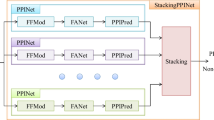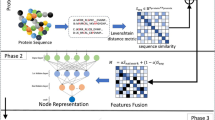Abstract
Protein–protein interactions (PPIs) are of critical importance in numerous biological processes and disease mechanisms, and the accurate prediction of PPIs is helpful in the comprehension of complex biological systems. In this paper, MFC-PPI, a PPI prediction model based on multimodal feature fusion and contrastive learning, is proposed. The sequential features, structural features, and PPI network features of proteins are extracted and combined for prediction. The contrastive learning is used to compare the subtle difference between the sequential features and structural features. In addition, the feature enhancement module is designed for feature fusion. The comparative experiments on SHS27k and SHS148k datasets demonstrates the excellent performance of MFC-PPI over other state-of-art methods under three partitioning strategies, Random, BFS, and DFS.








Similar content being viewed by others
Data availability
The implementation of MFC-PPI and the preprocessed data is available at: https://github.com/Zhangzxin24/MFC-PPI.
References
Ito T, Chiba T, Ozawa R, Yoshida M, Hattori M, Sakaki Y (2001) A comprehensive two-hybrid analysis to explore the yeast protein interactome. Proc Natl Acad Sci 98(8):4569–4574
Lin J-S, Lai E-M (2017) Protein–protein interactions: co-immunoprecipitation. Bacterial protein secretion systems: Methods and protocols, pp 211–219. https://doi.org/10.1007/978-1-4939-7033-9_17
Ho Y, Gruhler A, Heilbut A, Bader GD, Moore L, Adams S-L, Millar A, Taylor P, Bennett K, Boutilier K et al (2002) Systematic identification of protein complexes in saccharomyces cerevisiae by mass spectrometry. Nature 415(6868):180–183
Wang H, Chen B, Sun H, Zhang Y (2024) Carbon-based molecular properties efficiently predicted by deep learning-based quantum chemical simulation with large language models. Comput Biol Med 176:108531
Qiu X, Wang H, Tan X, Fang Z (2024) Gk bertdta: a graph representation learning and semantic embedding-based framework for drug-target affinity prediction. Comput Biol Med 173:108376
Tang T, Zhang X, Liu Y, Peng H, Zheng B, Yin Y, Zeng X (2023) Machine learning on protein–protein interaction prediction: models, challenges and trends. Brief Bioinform 24(2):076
Catacutan DB, Alexander J, Arnold A, Stokes JM (2024) Machine learning in preclinical drug discovery. Nat Chem Biol 20(8):960–973
Ahmed Z, Mohamed K, Zeeshan S, Dong X (2020) Artificial intelligence with multi-functional machine learning platform development for better healthcare and precision medicine. Database 2020:010
MacEachern SJ, Forkert ND (2021) Machine learning for precision medicine. Genome 64(4):416–425
Soleymani F, Paquet E, Viktor H, Michalowski W, Spinello D (2022) protein–protein interaction prediction with deep learning: a comprehensive review. Comput Struct Biotechnol J 20:5316–5341
Hu L, Wang X, Huang Y-A, Hu P, You Z-H (2021) A survey on computational models for predicting protein–protein interactions. Brief Bioinform 22(5):036
Guo Y, Yu L, Wen Z, Li M (2008) Using support vector machine combined with auto covariance to predict protein–protein interactions from protein sequences. Nucleic Acids Res 36(9):3025–3030
Hashemifar S, Neyshabur B, Khan AA, Xu J (2018) Predicting protein–protein interactions through sequence-based deep learning. Bioinformatics 34(17):802–810
Chen M, Ju CJ-T, Zhou G, Chen X, Zhang T, Chang K-W, Zaniolo C, Wang W (2019) Multifaceted protein–protein interaction prediction based on siamese residual rcnn. Bioinformatics 35(14):305–314
Gao Z, Jiang C, Zhang J, Jiang X, Li L, Zhao P, Yang H, Huang Y, Li J (2023) Hierarchical graph learning for protein–protein interaction. Nat Commun 14(1):1093
Zhang F, Chang S, Wang B, Zhang X (2024) Dssgnn-ppi: a protein–protein interactions prediction model based on double structure and sequence graph neural networks. Comput Biol Med 177:108669
Jumper J, Evans R, Pritzel A, Green T, Figurnov M, Ronneberger O, Tunyasuvunakool K, Bates R, Žídek A, Potapenko A et al (2021) Highly accurate protein structure prediction with alphafold. Nature 596(7873):583–589
Li S, Huang J, Zhang Z, Liu J, Huang T, Chen H (2018) Similarity-based future common neighbors model for link prediction in complex networks. Sci Rep 8(1):17014
Kipf TN, Welling M (2016) Semi-supervised classification with graph convolutional networks. arXiv preprint arXiv:1609.02907
Lv G, Hu Z, Bi Y, Zhang S (2021) Learning unknown from correlations: Graph neural network for inter-novel-protein interaction prediction. arXiv preprint arXiv:2105.06709
Kang Y, Elofsson A, Jiang Y, Huang W, Yu M, Li Z (2023) Aftgan: prediction of multi-type ppi based on attention free transformer and graph attention network. Bioinformatics 39(2):052
Kang Y, Wang X, Xie C, Zhang H, Xie W (2023) Bbln: a bilateral-branch learning network for unknown protein–protein interaction prediction. Comput Biol Med 167:107588
Albu A-I, Bocicor M-I, Czibula G (2023) Mm-stackens: a new deep multimodal stacked generalization approach for protein–protein interaction prediction. Comput Biol Med 153:106526
Zhang D, Kabuka MR (2018) Multimodal deep representation learning for protein–protein interaction networks. In: 2018 IEEE International Conference on Bioinformatics and Biomedicine (BIBM), pp. 595–602. IEEE
Liu L, Zhu X, Ma Y, Piao H, Yang Y, Hao X, Fu Y, Wang L, Peng J (2020) Combining sequence and network information to enhance protein–protein interaction prediction. BMC Bioinform 21:1–13
Chen T, Kornblith S, Norouzi M, Hinton G (2020) A simple framework for contrastive learning of visual representations. In: International Conference on Machine Learning, pp. 1597–1607. PMLR
Szklarczyk D, Gable AL, Lyon D, Junge A, Wyder S, Huerta-Cepas J, Simonovic M, Doncheva NT, Morris JH, Bork P et al (2019) String v11: protein–protein association networks with increased coverage, supporting functional discovery in genome-wide experimental datasets. Nucleic Acids Res 47(D1):607–613
Chen J, Gan Z, Li X, Guo Q, Chen L, Gao S, Chung T, Xu Y, Zeng B, Lu W, et al. (2021) Simpler, faster, stronger: Breaking the log-k curse on contrastive learners with flatnce. arXiv preprint arXiv:2107.01152
Xu K, Hu W, Leskovec J, Jegelka S (2018) How powerful are graph neural networks? arXiv preprint arXiv:1810.00826
Varadi M, Bertoni D, Magana P, Paramval U, Pidruchna I, Radhakrishnan M, Tsenkov M, Nair S, Mirdita M, Yeo J et al (2024) Alphafold protein structure database in 2024: providing structure coverage for over 214 million protein sequences. Nucleic Acids Res 52(D1):368–375
Khan H, Usman MT, Rida I, Koo J (2024) Attention enhanced machine instinctive vision with human-inspired saliency detection. Image Vis Comput 152:105308
Usman MT, Khan H, Singh SK, Lee MY, Koo J (2024) Efficient deepfake detection via layer-frozen assisted dual attention network for consumer imaging devices. IEEE Transactions on Consumer Electronics. https://doi.org/10.1109/tce.2024.3476477
Wong L, You Z-H, Li S, Huang Y-A, Liu G (2015) Detection of protein–protein interactions from amino acid sequences using a rotation forest model with a novel pr-lpq descriptor. In: Advanced Intelligent Computing Theories and Applications: 11th International Conference, ICIC 2015, Fuzhou, China, August 20-23, 2015. Proceedings, Part III 11, pp. 713–720. Springer
Silberberg Y, Kupiec M, Sharan R (2014) A method for predicting protein–protein interaction types. PLoS ONE 9(3):90904
Khan H, Ullah I, Shabaz M, Omer MF, Usman MT, Guellil MS, Koo J (2024) Visionary vigilance: optimized yolov8 for fallen person detection with large-scale benchmark dataset. Image Vis Comput 149:105195
Linderman GC, Rachh M, Hoskins JG, Steinerberger S, Kluger Y (2019) Fast interpolation-based t-sne for improved visualization of single-cell rna-seq data. Nat Methods 16(3):243–245
Acknowledgements
This work was supported by National Natural Science Foundation of China (12371491).
Author information
Authors and Affiliations
Contributions
Z.Z.wrote the main manuscript text. J.X., Q.Z., and S.D. contributed to data analysis and figure preparation. Z.L. supervised the research and reviewed the manuscript. All authors approved the final version of the manuscript.
Corresponding author
Ethics declarations
Conflict of interest
No conflict of interest is declared.
Additional information
Publisher's Note
Springer Nature remains neutral with regard to jurisdictional claims in published maps and institutional affiliations.
Rights and permissions
Springer Nature or its licensor (e.g. a society or other partner) holds exclusive rights to this article under a publishing agreement with the author(s) or other rightsholder(s); author self-archiving of the accepted manuscript version of this article is solely governed by the terms of such publishing agreement and applicable law.
About this article
Cite this article
Zhang, Z., Zhang, Q., Xiao, J. et al. MFC-PPI: protein–protein interaction prediction with multimodal feature fusion and contrastive learning. J Supercomput 81, 579 (2025). https://doi.org/10.1007/s11227-025-07076-2
Accepted:
Published:
DOI: https://doi.org/10.1007/s11227-025-07076-2




